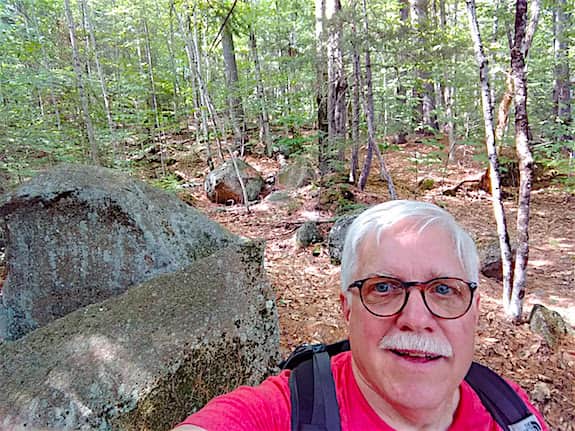
Here I am on the loop trail at Fay State Forest in New Hampshire. I didn’t expect it to be as gorgeous as it was. I’ll be back for sure in the fall. Copyright 2018 Tim Carter
Fay State Forest – An Enchanted Tiny Woodland
Today I activated Fay State Forest in New Hampshire as part of the Parks on the Air (POTA) program. I did it with loads of help from my outdoor radio and CW mentor, Jim Cluett – W1PID.
Kay State Forest is a small 200-acre piece of pristine forest just west of both Route 3 and Lincoln, NH. The southern boundary of the forest shares the Woodstock, NH northern town line.
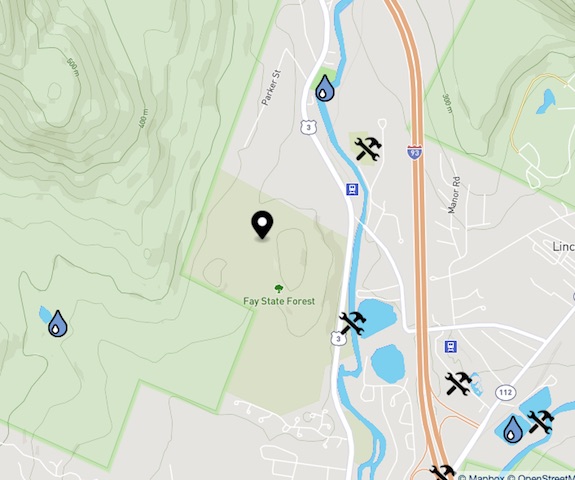
You can see Fay State Forest. Copyright 2018 OpenStreetMap.org
It’s an undeveloped piece of land with no roads or improvements on it whatsoever. We discovered a small gravel turnout on Route 3 just 100 feet north of the sign welcoming you into Woodstock.
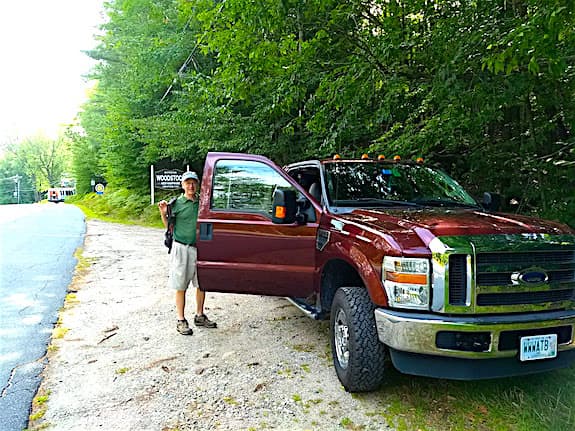
Here’s Jim getting ready to wander up into Fay State Forest. We were lucky to find this turnout on the west side of Route 3 just north of the Woodstock town line. Copyright 2018 Tim Carter
Much to our surprise, there was a well-worn footpath leading you into the magic forestland. We were glad to not have to bushwack up into the trees to find a place to set up my Elecraft KX2 radio.
The Fay State Forest Loop Trail
Jim and I saw what appeared to be a loop trail and we made a left turn to proceed clockwise around the trail. The path was covered with a carpet of soft brown pine needles. It was like walking on a pillow.
Giant boulders plucked from the bedrock by the last period of Continental Glaciation were strewn about the forest. We even contemplated setting up on top of one that must have been 15 feet tall and 60, or more, feet in circumference.
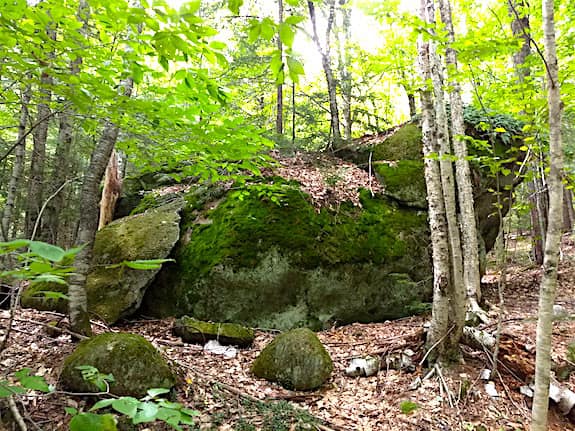
This boulder may not look that big, but it was huge. Six people could easily sit on top and not be crowded. Copyright 2018 Tim Carter
After walking just ten minutes we could tell we were on our way back to my truck so we decided to use a massive 200-foot-tall pine tree as our antenna support.
Jim used my water bottle and made a remarkable throw at least 50 feet up into the air snagging the perfect branch so we’d have a vertical antenna. He wanted me to make the throw at first to a higher branch, but I thought the challenge was too great.
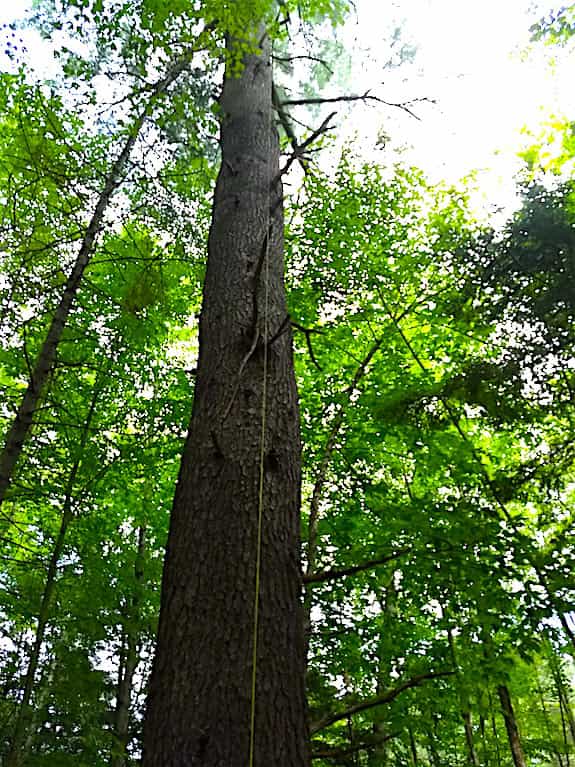
This is just part of the giant pine tree! I cut off at least 12 feet at the bottom and the top of the tree must be 100 feet, or more, higher than the top of the photo. That yellow line is the halyard ready to pull up my 29-foot 26-gauge antenna wire. A 9:1 unun is attached to the bottom of the wire and a 25-foot coax cable stretches back to the radio. The top of the antenna was about 42 feet off the ground. Copyright 2018 Tim Carter
Little did I know he’d carry the day in more ways than just this throw.
Switch From Plan A to Plan B
Earlier in the day, I had posted on the POTA Scheduled Activations page that I’d be on the air by 1730 UTC, or 1:30 PM Eastern Time. Jim and I were set up and on the air seven minutes early.
While I had posted the frequencies I’d be on, 20, 30, and 40 meters, I didn’t post a specific frequency. That’s hard to do because you never know if that frequency is already in use when you power up your radio.
I called CQ POTA W3ATB W3ATB K4900 K several times hoping the skimmers would hear me and/or a POTA chaser operator. No one answered my call.
My signal was heard by two skimmers, but it wasn’t enough to alert POTA chaser operators who might answer my call all at the same time. When that happens, you get a mini pile-up. I was hoping for that to happen as we drove to the forest.
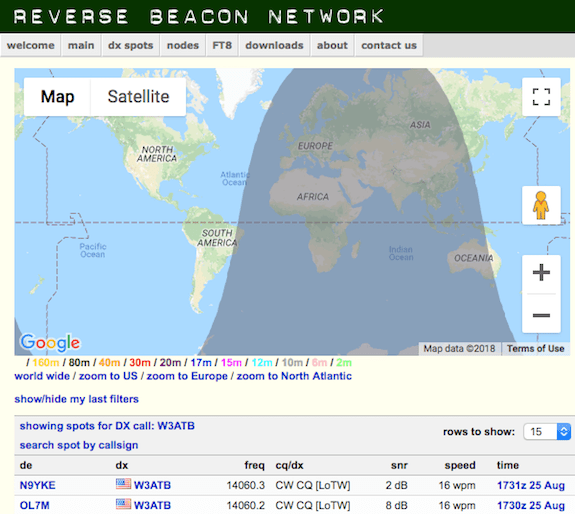
You can see my call sign and the 1730 UTC time stamp for today. The Reverse Beacon Network is an amazing tool that helps you see who’s hearing your signal and how strong it is.
After five minutes of growing frustration, Jim said, “Spin the dial and go find someone and make a QSO.”
Thank the Contesters!
We were fortunate that we did this activation on a weekend. Long ago Jim taught me that low-powered outdoor radio is very likely the toughest thing to do.
The conditions can be challenging, the antenna might be marginal, and you’re lucky to be transmitting at, or above, 5 watts. If you don’t know much about amateur radio, that’s the amount of power you use to illuminate an incandescent night light.
It didn’t take long for us to find activity. Fortunately, there were quite a few signals on 20 meters. The Kansas QSO party was in full swing and my log book started to fill up with contacts. We needed ten to activate this rare POTA entity. I was the first person in the USA to attempt an activation here, so I wanted to get the required ten contacts.
My fourth contact was a DX one, OZ2TF, in Denmark. I was quite happy to see my signal was bouncing well off the waters of the Atlantic Ocean! Jim and I are lucky to live in New Hampshire and we regularly log European stations because the nearby ocean helps reflect our weak signals eastward.
We milked 20 meters for all we could and switched to 40 meters. The Ohio QSO party stations were booming into us and in short order, we hit the required ten contacts. I was elated and Jim was happy to help log contacts.
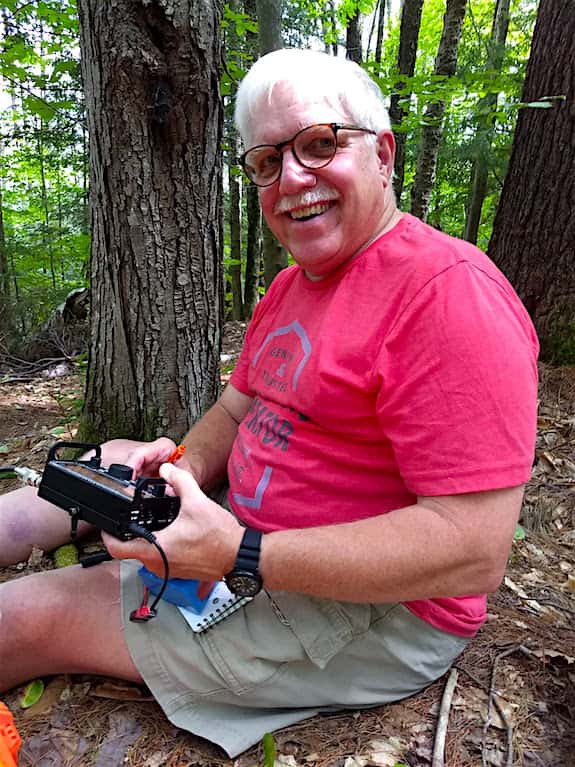
I’m pretty happy about my log book filling up with contacts. Victory! First to activate Fay State Forest K-4900. Copyright 2018 Jim Cluett
Here’s my log:
Call Sign Time Frequency Signal Report
| W0K | 1738 UTC | 14.044 | 599 |
| N0C | 1745 UTC | 14.049 | 599 |
| NS8G | 1750 UTC | 14.045 | 599 |
| OZ2TF | 1755 UTC | 14.050 | 599 |
| K0N | 1759 UTC | 14.031 | 599 |
| W0S | 1800 UTC | 14.030 | 599 |
| K8AJS | 1808 UTC | 7.045 | 599 |
| N8BJG | 1810 UTC | 7.047 | 599 |
| KE8G | 1811 UTC | 7.041 | 599 |
| KI8R | 1813 UTC | 7.046 | 599 |
| W8ERD | 1824 UTC | 14.046 | 599 |
A Learning Experience at Fay State Forest K-4900 POTA
I have to admit the day turned out far different than what I envisioned. While driving to Kay State Forest I said to Jim, “Today you’re going to see what a well-oiled machine can do during a POTA activation.” Jim wisely didn’t respond. He’s more an actions-speak-louder-than-words type of guy.
Here are my main takeaways from today’s adventure at Fay State Forest:
- If operating QRP, low power, then, by all means, favor contesting days
- Don’t underestimate your ability to sling a water bottle 60 feet into the air
- Respect solar minimums
- Always invite a seasoned outdoor operator on a POTA activation
I’m very satisfied with the results of this activation, but as I drove back down I-93 I thought about how much I still have to learn. Just a few weeks ago I pronounced to Jim during the QRP Bumblebee contest I was a flippin’ operator. After today I wonder if I shouldn’t dial that assessment back a notch or two.

Sorry I missed you, Tim. I’m at K-1342 (Codorus SP, PA) for 3 days. I did manage 2 park-to-park QSOs with N2CX.
Craig,
Jim and I had a great time. The forest was magical. GL at K-1342! I’ll try to listen for you tomorrow and work you from home if possible.